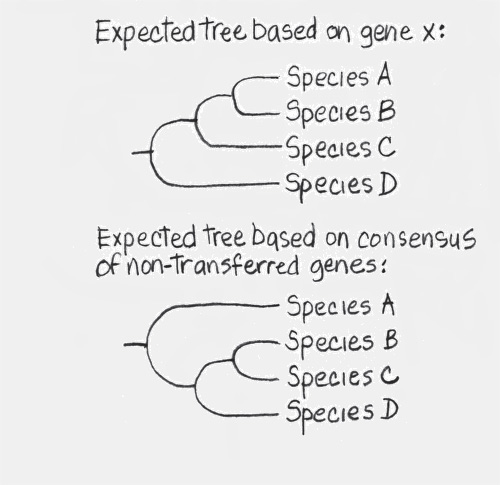recap
25.1 recap
Bacteria and Archaea are the two major divisions of the tree of life. Eukaryotes evolved from a group of prokaryotic archaea that captured and incorporated at least two different bacteria through endosymbiosis. Environmental genomic studies have revealed a much higher diversity of prokaryotes than was previously known.
learning outcomes
You should be able to:
Compare and contrast the features of bacteria and prokaryotic archaea in a phylogenetic context.
Distinguish between two scenarios for the contributions of bacteria and archaea to eukaryotes.
Draw phylogenetic trees demonstrating the effects of lateral gene transfer.
1.
What findings led to the establishment of Bacteria and Archaea as separate domains?
Before DNA sequencing was developed, biologists usually grouped all prokaryotes together, emphasizing the differences between eukaryotes and prokaryotes. But the characteristics that differentiated these two “groups” (such as the presence of a nucleus, or the various organelles) are all derived features of eukaryotes. When gene sequences were compared across all of life (especially the ribosomal RNA genes, which are easily compared across all living organisms), it became clear that the diversity among “prokaryotes” was far greater than the diversity among eukaryotes. Indeed, it soon became apparent that the ribosomal RNA genes of prokaryotic archaea were actually more similar to the ribosomal genes of eukaryotes than they were to the ribosomal RNA genes of bacteria, and Archaea was proposed as a domain separate from Bacteria. As biologists studied Archaea in more detail, they discovered that many other features were also distinct from Bacteria.
2.
The figure at right shows an organismal tree in which gene x has undergone a lateral transfer event. Draw the phylogenetic tree you would expect based on gene x, as well as the phylogenetic tree you would expect based on a consensus of non-


3.
How did eukaryotes arise through evolutionary contributions from both prokaryotic archaea and bacteria?
The genomes of eukaryotes contain mostly genes that are more closely related to prokaryotic archaea than to bacteria. This leads biologists to conclude that an ancestral prokaryotic archaean lineage first acquired the features that are characteristic of eukaryotes (such as the nucleus). These early eukaryotes then acquired an endosymbiotic proteobacterium, which was eventually incorporated as the eukaryote mitochondrium. Later, one group of eukaryotes acquired another endosymbiont, this time an early cyanobacterium, which became the chloroplast of photosynthetic eukaryotes.
Despite the challenges of reconstructing prokaryote phylogeny, taxonomists are starting to establish evolutionary classification systems for these organisms. With a full understanding that new information requires periodic revisions in these classifications, we will next apply a current system of classification to organize our survey of prokaryote diversity.